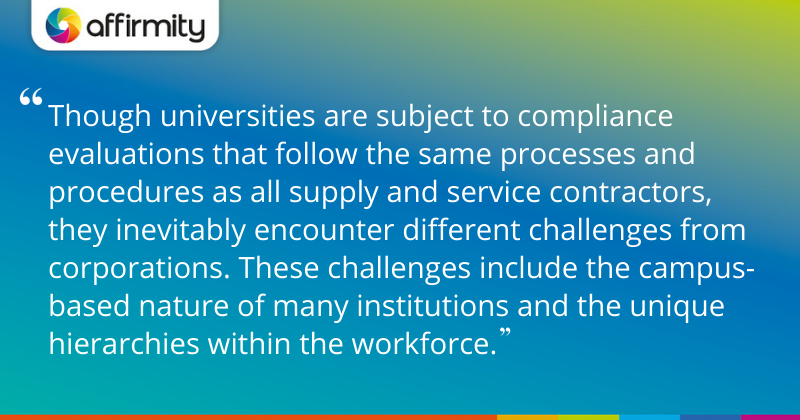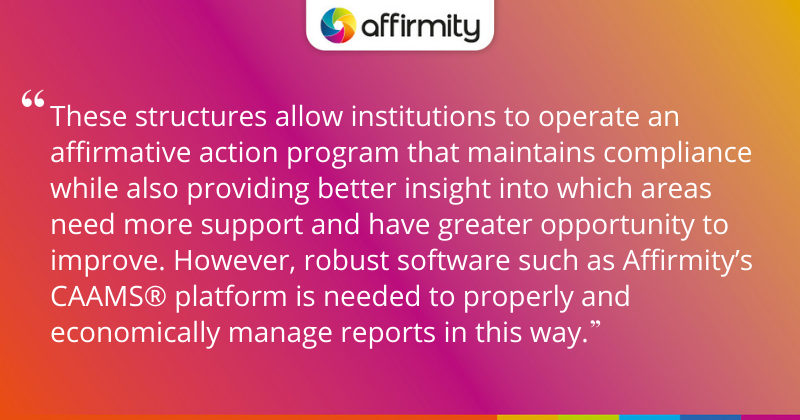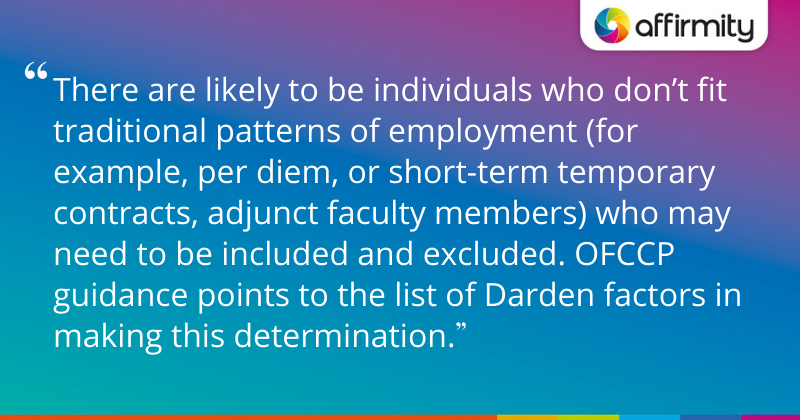Educational institutions that enter into federal contracts must comply with the same evaluations, processes, and procedures that all contractors are subject to. However, affirmative action plan preparation guidance often heavily focuses on the corporate world, when educational institutions have different governance, organizational, and workforce structures that must be accounted for. In this article, Kim Hendon, Affirmity’s Vice President of Sales, takes a look at some higher education-specific considerations for creating AAPs.
The new school year is in full swing. Students have settled into their new routines and once new faces among faculty and staff have slowly become familiar fixtures in school life. As the administration considers the year ahead, perhaps their thoughts will turn to compliance concerns—and if they have any federal contracts, their affirmative action obligations.
An Important Clarification on Affirmative Action in Higher Education
To be clear, the topic at hand is affirmative action in higher education employment, rather than the practice of affirmative action in college admissions. The Supreme Court’s June 2023 ruling, that the use of race as a factor in admissions is unconstitutional, has no direct legal impact on the employment space.
The laws and regulations enforced by the EEOC and the OFCCP have long held that race or gender cannot be a factor in making employment decisions. While affirmative action can no longer be applied to the college admissions process, universities are still obligated to ensure they’re employing people in accordance with equal employment opportunity laws, and developing affirmative action programs when required.

When Are Higher Education Institutions Required to Prepare AAPs?
Broadly speaking, universities that:
- Receive federal funding such as research grants and contracts,
- Enter into direct contracts to provide services/resources to a federal agency,
- Are subcontracted to provide services,
Are required to prepare an annual affirmative action plan under Executive Order 11246. This assumes that they also have 50 or more employees and their contracts (or subcontracts) reach the required dollar thresholds that apply to all organizations, regardless of type.
Please also note that the type of grant your institution receives is also significant. The main exception to be aware of are Pell Grants. According to the OFCCP’s Educational Institutions Technical Assistance Guide (available from the office’s compliance assistance guides page):
“Except for federally assisted construction contracts, which are specifically covered by sections 301-304 of Executive Order 11246, neither Executive Order 11246, nor Section 503, nor VEVRAA applies to arrangements involving federal financial assistance. For example, solely serving as a conduit for Pell Grants does not render a post-secondary higher education institution a covered contractor.”
3 Unique Higher Education AAP Challenges and How to Address Them
Though universities are subject to compliance evaluations that follow the same processes and procedures as all supply and service contractors, they inevitably encounter different challenges from corporations. These challenges include the campus-based nature of many institutions and the unique hierarchies within the workforce, as well as differences in how to approach available labor and job classifications, and job grouping.

1) Structuring AAPs to Account for How Higher Education Is Organized
One of the very first steps for building higher education AAPs will be to consider the structure of your plans, and how the program should be disseminated to key stakeholders.
The OFCCP largely leaves plan structure up to its contractors. The technical assistance guide says the following:
“Educational institutions may develop and implement a single AAP or multiple AAPs, depending on how the operations of the educational institution is organized. Some contractors with campus-like settings may have multiple buildings or schools that each constitute an establishment for the purposes of developing and maintaining an AAP, while others may determine that a single AAP for all buildings or schools better fits their operations, size, and organizational structure.”
The technical assistance guide provides a list of criteria for determining whether operations for buildings and schools are distinct or interconnected on pages 7 and 8.
If you have multiple campuses in your university system, you may want to ensure that reporting not only allows you to have a plan that looks at the overall system, but also individual plans for each campus, colleges within the campuses, and each dean within each college.

Fig. 1: Example affirmative action plan structure for a higher education institution, wherein specific deans covering multiple departments get separate plans. The individual colleges, campuses and universities also receive dedicated plans.
Plan structures should be defined based on the needs of your institution. One of our consultants offers the example of one university that has a slightly more expansive structure with the following views:
- University-wide reporting for providing a compliance-level view
- Work unit, with the purpose of dividing up different types of workers. Example groupings include faculty, certain management levels, faculty chairs, and civil service jobs
- Divisions (typically staff-focused)
- Colleges (typically faculty-focused)
- Departments
Another approach our consultants have seen involves having separate plans based on the institution’s recruiting—for example, the different metropolitan areas from which they pull.
A further example is of an institution that reports to the OFCCP using FAAPs (Functional Affirmative Action Plans). It produces around 30 plans for various vice presidents across a mix of colleges and functions.
Whether producing functional or establishment-based AAPs, institutions with multiple plans often have a vice president, provost or a hierarchy they want to be responsible for an AA plan. So someone who is responsible for operations at the university’s medical school or research foundation would be responsible for the corresponding AAP, even if they’re not physically located on the same campus. It’s not uncommon for leadership to be based on a different campus in this way,
These structures allow institutions to operate an affirmative action program that maintains compliance while also providing better insight into which areas need more support and have greater opportunity to improve. However, robust software such as Affirmity’s CAAMS® platform is needed to properly and economically manage reports in this way.
2) Understanding and Effectively Using Higher Education Availability Sources
While American Community Survey data is widely used for corporate Affirmative Action planning, in the OFCCP’s technical assistance guide universities are directed to a number of education-focused resources when dealing with the availability of faculty. These include:
- The Integrated Postsecondary Education Data System (IPEDS), which offers a range of data from participating colleges, universities, and technical and vocational institutions. This incorporates enrollment data by discipline, and staff by occupational activity and faculty status.
- Survey of Earned Doctorates (SED) data, as collected by the National Science Foundation (NSF), offering statistics on doctoral, master’s, and bachelor’s recipients.
- Various additional data sources across medicine, nursing, dentistry, law, science, and other fields (see Appendix C, page 68).
Affirmity’s consultants typically use a combination of SED and census data when determining availability for their higher education clients (for doctorate-level faculty and staff respectively), and this data is readily available in Affirmity software. This survey collects data on the educational and career paths of individuals who have recently earned their doctoral degrees. The data therefore provides the true availability of individuals who have the skillset necessary to fill roles requiring a PhD.

3) Job Classification and Grouping Within Higher Education AAPs
There are a number of further considerations about what—and who—goes into your institution’s AAPs. One such consideration is determining employment status, as there are likely to be individuals who don’t fit traditional patterns of employment (for example, per diem, or short-term temporary contracts, adjunct faculty members) who may need to be included and excluded. OFCCP guidance points to the list of Darden factors in making this determination. Additionally, the technical assistance guide also reminds contractors that, after issuing Directive 2019-05, the OFCCP “will not cite violations for excluding student workers from AAPs or personnel activity data submissions in compliance evaluations.”
Equipped with this knowledge of who to include, a remaining issue is how individuals should be classified and grouped in your plans. In its technical assistance guide, the OFCCP directs institutions to use:
- Classification of Instructional Programs (CIP) codes for instructional staff
- IPEDS, EEO-1, or EEO-6 categories for non-instructional staff
As the technical assistance guide notes, “If the categories used are too broad for meaningful analyses, they may still serve as a starting point for narrowing down to the appropriate job groups.”
In addition to separating faculty and non-faculty positions, a separation between tenured and non-tenured job groups should also be considered. Furthermore:
- The job group structure should be refined to ensure that positions within each have similar Content (role responsibilities), similar Opportunity to advance, and are similar in Wage.
- In order to gain real insight into the program, each job group should be large enough to yield a valid grouping. As a guideline, the grouping should contain at least five employees while still reflecting the distinctions mentioned above in order to sustain meaningful analysis.
In Conclusion
By addressing each of the challenges above, universities can develop and maintain an effective affirmative action plan that goes beyond compliance and promotes a diverse and inclusive environment. There are, however, a large number of moving parts to consider: multiple plans and reports to define and build, availability sources to source, and job categorizations to perform. This is work that benefits from outside expertise—and our experienced consultants are here to help.
For help with any and all aspects of Higher Education Affirmative Action Plan Preparation, please contact us today.
About the Author
 Kim Hendon, Vice President of Sales, oversees account management and sales for Affirmity. She is responsible for building successful, long-term partnerships with clients for generating new business. Having served with the company for more than 20 years, Ms. Hendon has in-depth knowledge and broad experience in all areas of compliance and diversity.
Kim Hendon, Vice President of Sales, oversees account management and sales for Affirmity. She is responsible for building successful, long-term partnerships with clients for generating new business. Having served with the company for more than 20 years, Ms. Hendon has in-depth knowledge and broad experience in all areas of compliance and diversity.
Ms. Hendon assists clients with planning and development of affirmative action programs, diversity initiatives, and diversity training.
